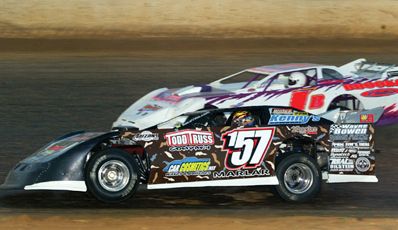
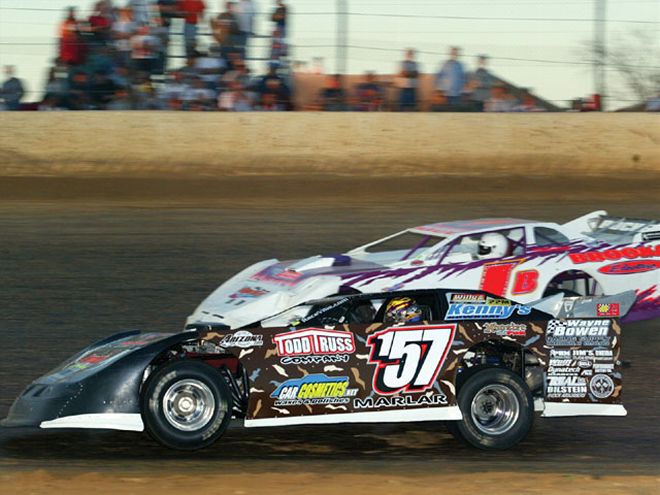 The common practice of three-wheeling the car off the turns and down the straightaway is quickly becoming a thing of the past. More top dirt racing teams are finding more consistency by keeping all four tires on, or near, the ground.
The common practice of three-wheeling the car off the turns and down the straightaway is quickly becoming a thing of the past. More top dirt racing teams are finding more consistency by keeping all four tires on, or near, the ground.
Dirt car setup is far more complicated than setting up an asphalt stock car. In many of our articles on various aspects of chassis setup, we try to include both sides of the coin-dirt and asphalt. This article is all about dirt car setup and nothing else. It is so specialized and the techniques have developed so much over the past five years or so that it is time to spill the beans on what is working and why.
Setting up a dirt car is complicated, not only by the fact that the surface is difficult to work with, but mostly by the way it is constantly changing. You must be willing to make rapid changes to meet the requirements of the racing surface. Too many teams, surprisingly on the professional side of dirt racing, also, will come to an event and make few chassis adjustments when the track conditions continue to change drastically from practice, through qualifying, during the heat races, and finally in the main event. It's no wonder that the pole car seldom wins.
The routine for setting up a dirt car should start in the shop. A team must anticipate the conditions it will encounter at the next track it plans to race. Decisions concerning spring changes, tire selection and grooving, rear suspension adjustment, weight distribution, and even the front geometry should be finalized, and notes should be handy so the team can make deliberate and quick changes as they become necessary.
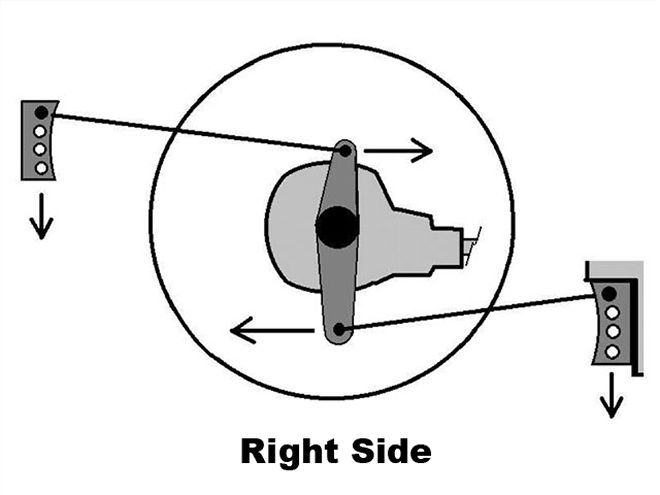 The two most common types of rear suspension links are the Z-link (left) and the four-bar (right). Some teams will use a Z-link on the right side of the car...
The two most common types of rear suspension links are the Z-link (left) and the four-bar (right). Some teams will use a Z-link on the right side of the car...
That's easy to say, I know, but it can and is done by many of the winning teams. It's easy to write one thing and allude to changes in technology as being "cutting edge" or "state-of-the-art," but what really governs the significance of any new technology is hearing it from the actual racers, especially the ones who often win. The ones we spoke with were in agreement that times have definitely changed.
"Racers these days are more technology minded," says Billy Moyer, one of the top dirt Late Model drivers over the past 20 years. "They want to know more about how their cars work. The joy of dirt racing is being able to learn how to make all of the adjustments work together to improve the car's performance." Moyer doesn't pretend to know it all and says each year is a learning experience for him. That can be said for us all.
Brian Birkhofer, runner-up in the competitive Xtreme Dirt Car Series in 2003, states, "There is a changing of the guard happening at the end of this year [2003]. What would have worked in the past is no longer good enough." Birkhofer says his team is working to make the car more balanced, learning the exact location of the moment center design. They have already experimented with different spindles and other adjustments to find the best configuration.
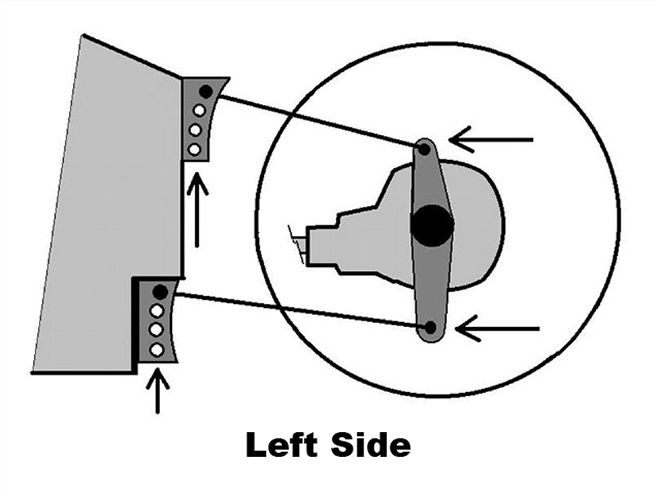 ...and a four-link on the left side. This helps them control the rear steer characteristics between the different setups.
...and a four-link on the left side. This helps them control the rear steer characteristics between the different setups.
Let's take a look at the different elements to work with on a dirt car. For the most part, we'll present information about the Late Model designs, but much information can be utilized by all dirt racers, from Stocks to Modifieds.
Front End Geometry
A good setup starts up front with the geometry of the front suspension. Don't begin to think this is not important, because it is. Furthermore, some of the top car builders in many different classes of dirt car racing, including the Modifieds and Late Models, have redesigned their front ends for better moment center location and camber change characteristics. Partial proof came to me as I was putting this story together. A team sent me the geometry data from its Late Model car purchased from a recognizable car builder; the car was very well designed. Only a couple of years ago, many other brands of this car type were terrible in their designs because none of us knew any better.
Know as much as you can about your front end geometry, and don't be afraid to change things to make it better. The most influential factor concerning the front geometry is the track's banking angle. The higher the banking, the farther the moment center can be located to the right in the car. MCs located to the left are useful for the flatter, slicker tracks.
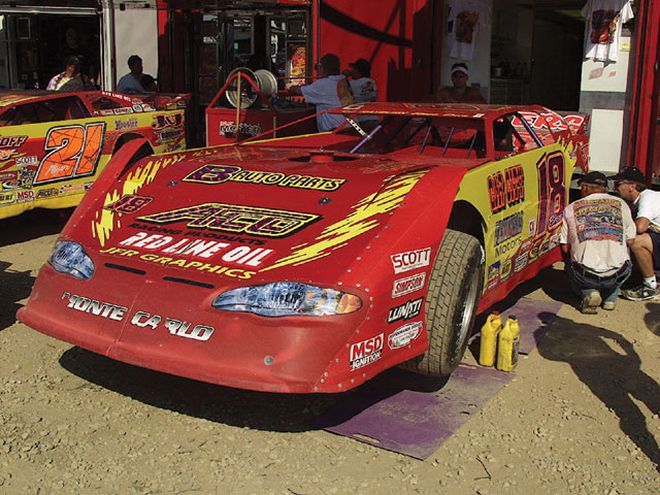 This IMCA dirt Modified utilized a Z-link rear suspension. Note there are two holes for the coilover mount on the lower arm. Moving the mount changes the motion ratio of the arm and the spring rate that is felt by the chassis. Using a 200-pounds per inch (ppi) rated spring, the front hole would yield a net spring rate of about 110 pounds. Moving the spring to the back hole would increase the net spring rate by 20 pounds to about 130 ppi.
This IMCA dirt Modified utilized a Z-link rear suspension. Note there are two holes for the coilover mount on the lower arm. Moving the mount changes the motion ratio of the arm and the spring rate that is felt by the chassis. Using a 200-pounds per inch (ppi) rated spring, the front hole would yield a net spring rate of about 110 pounds. Moving the spring to the back hole would increase the net spring rate by 20 pounds to about 130 ppi.
Rear Geometry
There are probably several hundred different configurations we can use in typical four-link or Z-link rear suspensions. If we combine the different bar angle possibilities with the various spring placements, indexing properties of the birdcages, pull bar angles and spring rates, lift arm rates that regulate lift on acceleration and compression during braking, shock rates for the four corners, plus the fifth and sixth coil, we begin to get the picture. The adjustment combinations are even much more than those for a Formula One or Indy car.
We need to decide what we want to achieve and then set the bars, etc., so that the car will do what we want. The various linkage designs from the four-bar to the Z-link offer possibilities for changing the rear steer characteristics as well as the distribution of weight while decelerating and while under acceleration loads.
Each side can be adjusted with respect to "front to rear movement" as the chassis moves vertically, or to steer either direction depending upon what the chassis is doing on a particular side of the car. The four-bar can be set up to move the wheel considerable distances fore and aft, and that movement can either help performance or put you out of contention.
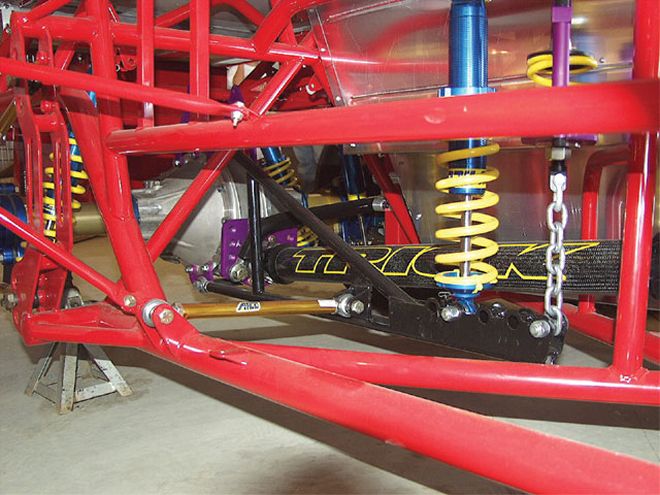 Most Late Model cars utilize birdcage-type attachment points where the linkages connect to the rear axle tubes. This allows the rear end to be free to rotate.
Most Late Model cars utilize birdcage-type attachment points where the linkages connect to the rear axle tubes. This allows the rear end to be free to rotate.
Rear geometry deals not only with wheel movement, but also the forces associated with acceleration and braking. As we accelerate, there is a great amount of torque applied to the rear axle housing, and dirt car manufacturers have designed several systems to take advantage of that force. Among the most popular systems are the pull bar and the lift arm. Both help cushion the torque related to instant application of power to help the rear tires maintain grip with the racing surface, and to control the forces of engine and wheel braking when decelerating.
Both systems can utilize a shock that will control the speed of movement both ways. This is essential, because a spring will react relatively slowly when being compressed, and violently when released from compression. The shock controls both, but obviously must do much more work in the rebound mode.
Weight Distribution
The changing of the static distribution of weight in a dirt car can be accomplished in two ways: by moving weight around in the car or by adjusting the distribution of weight on the four wheels without moving actual weight. The latter involves changing the height of the spring by turning the adjusting ring at the top or bottom of each spring to regulate the amount of crossweight, or, in more familiar terms to dirt racers, the amount of left-rear (LR) weight.
 There are two devices that can be used to control and regulate the rotation of the rear end as the car is accelerating and braking. They are the lift arm (shown on the left) and the pull bar.
There are two devices that can be used to control and regulate the rotation of the rear end as the car is accelerating and braking. They are the lift arm (shown on the left) and the pull bar.
LR weight refers to the number of pounds of weight supported by the left-rear wheel versus the weight supported by the right-rear (RR) wheel. One hundred pounds of LR would indicate that if the car were weighed, the LR scale would read 100 pounds more than the RR scale. Setups can be developed around a particular LR weight number or the LR weight around a particular setup to tighten or loosen a car.
In some cases, high amounts of LR weight can produce less traction than smaller amounts. We generally relate high crossweight, or LR weight, with improved traction, but that's not always the case. If we have a car that utilizes all four tires (all on the ground with sufficient weight on them to make them work), we can definitely use a higher amount of LR weight to try to balance the weight across the rear tires. The more equally loaded a pair of tires is, the more available traction.
This does not work in the case of a setup that lifts the LF tire off the ground. Once the LF is elevated, all of the front weight of the car is supported by the RF tire. Since diagonal tires share the loads in combination, if the RF weight goes up, so does the LR weight. If there is already a high amount of LR weight supported by that tire, imagine what it is after the LF comes off the ground. For this reason, we need to run a much lower amount of LR weight with a three-wheel setup.
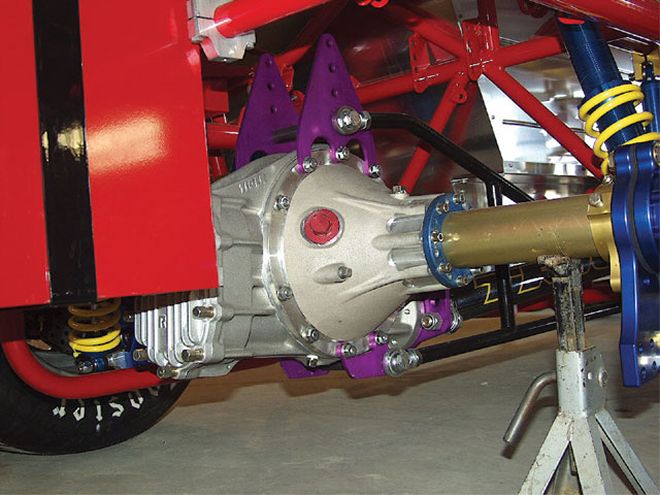 The lift arm attaches to the rear end housing and runs forward to an attachment point. The movement of the arm is controlled by a spring and shock on acceleration and on a spring when the car is braking.
The lift arm attaches to the rear end housing and runs forward to an attachment point. The movement of the arm is controlled by a spring and shock on acceleration and on a spring when the car is braking.
Tire Grooving and Siping
As track conditions change, so do our needs pertaining to tires. We usually have the opportunity to change the grooving in the tires to increase the grip and to help control heat buildup. This is a highly complex subject and best left to experts such as Professor C.P. Furney Jr., who took the time and effort to help us dirt racers understand more about dirt Late Model tires by writing a book about it. Selection and Application of Late Model Dirt Racing Tires is a comprehensive and detailed discussion about the properties of dirt tires and how to utilize them for different conditions.
We can change the characteristics of our dirt tires by understanding how the conditions of the track, at any given moment, affect the surface rubber on the tire. The idea is to help the tire produce the maximum allowable grip by making appropriate changes to the tread pattern by cutting (siping) or grooving. How do you do that? Read the book.
Dirt Car Aerodynamics
Most dirt racers probably do not agree that aero has a profound effect on dirt cars. For the most part, they are more right than wrong. On the other hand, aero may play a major role in dirt car performance, and our understanding of it may answer some nagging questions as to how certain setups work well and others do not.
When we examine the shape of the dirt car, we see large, flat sides, wedge-shaped noses, large rear spoilers, and open rears around the bumper. These are shapes that can produce considerable aero effects, both good and bad.
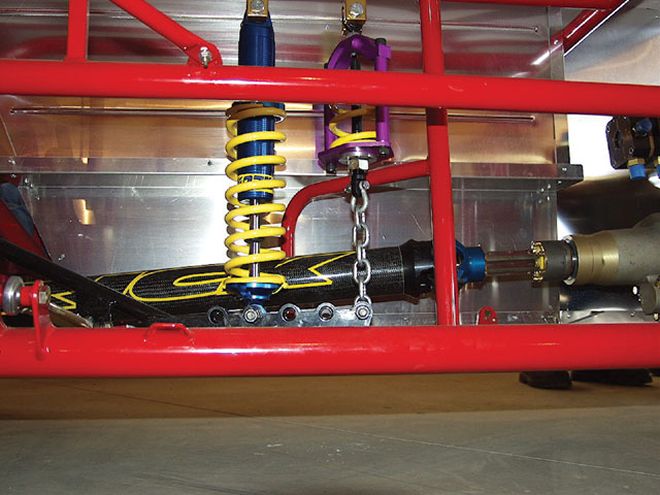 The fifth coil, which controls the acceleration forces, is to the rear. The sixth coil, which controls the braking forces, is to the front.
The fifth coil, which controls the acceleration forces, is to the rear. The sixth coil, which controls the braking forces, is to the front.
If you have ever observed a dirt Late Model car cruising through the pits at around 10 or 15 mph, you may have noticed a lot of dust billowing out of the back of the car. Have you ever wondered why there is so much disturbance of the dust on the ground? A pickup truck can go by and not move any dust, so what causes the difference? It is the suction created by air being pulled out of the back of the car as it moves through the air and sucks the dust up off the ground-and this is at only 10-15 mph. Think of the effect at 60-80 mph in the turns.
So if we agree that there is a low pressure effect and with it some amount of downforce, we might try to utilize that effect to our advantage. The car's attitude works to improve downforce or destroy it. Many racers struggle with a car that pushes on exit when the LF wheel, and the nose, is hiked up a foot or more off the ground. No wonder it pushes; the car is catching a lot of air under the LF, and that might cause aero lift instead of aero downforce.
The car might stick better up front, through the middle, and off the corner if we can keep the LF corner down and allow the aerodynamic downforce to work. All is going to be lost once that LF comes up as we accelerate.
Tight, Moist Tracks
Most dirt tracks start an event with a lot of moisture due to the crew watering and/or tearing up the surface prior to the event. The conditions do not usually change much from practice to qualifying, and the surface may become even more moist if the crew waters the track prior to the qualifying runs.
The trend among top racers has been to run more even spring rates across the front and rear and a more level track bar to balance the setup when there is a lot of traction. The bar may even be mounted on the right side of the chassis for more consistency. We need all of this when the tracks more closely resemble asphalt conditions as the G-forces increase. We can then utilize all four tires and a more level body configuration relative to the track surface to improve the aero downforce that exists.
 For many top racers, the only time you'll see the LF tire off the ground is when the car is on jackstands. There are advantages to keeping the front of the car low into and off of the turns.
For many top racers, the only time you'll see the LF tire off the ground is when the car is on jackstands. There are advantages to keeping the front of the car low into and off of the turns.
The rear geometry needs to be arranged so that minimal rear steer takes place in order to keep the car going straight ahead, much like an asphalt car. With all four tires on the ground, a high amount of LR weight can be put in the car to provide improved traction off the corners. The car will turn in well and drive through the middle because of the balanced setup causing the LF tire to work to turn the car. Some racers have even been known to run a stiffer RR spring when conditions warrant less RR chassis travel.
Mid-Point Traction
As the track begins to dry out through the qualifying heat races, a team must observe the surface conditions during the heats just before they race. If the track is going black-slick, the setup may need to change as well as the tire selection. These slicker track conditions can cause excess heat buildup in the tires, and more siping is required to help cool the rubber.
The RR can be a little softer to promote traction off the corners, but that will produce more chassis roll at the rear and unload the LF tire. The LF is not going to hike up, but it will become less loaded. So the crossweight, or LR weight, will need to come down so that the balance of weight between the rear tires doesn't become uneven. This prevents a condition in which the LR (as well as the RF) ends up with a high weight while the RR supports very little weight. Less equally loaded rear tires mean less traction off the corners.
Dry, Slick Conditions
As the track dries out further and the surface becomes dry and slick, drastic measures must be taken. We need more weight transfer, a sideways attitude of the car relative to the direction of travel, and a rear geometry that will help overcome the tendency of the car to push on entry and through the middle.
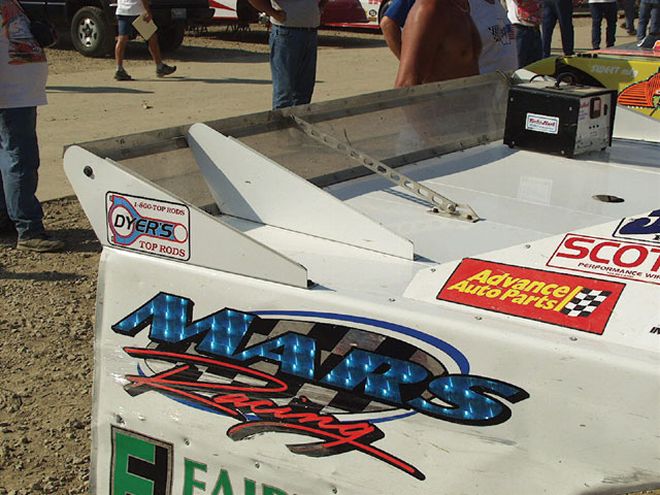 The rear spoiler found on most dirt cars produces downforce at the rear of the car, which promotes bite off the corners. Elevating the rear of the car through whatever means, such as using a left-side, short, high-angle Panhard bar mount so the LR corner is jacked up in the turns helps the aero effect of the spoiler. This may be a positive as long as the LF does not come up as well to make the car push off the corners. For every positive effect, there is a limit as to how far we can go.
The rear spoiler found on most dirt cars produces downforce at the rear of the car, which promotes bite off the corners. Elevating the rear of the car through whatever means, such as using a left-side, short, high-angle Panhard bar mount so the LR corner is jacked up in the turns helps the aero effect of the spoiler. This may be a positive as long as the LF does not come up as well to make the car push off the corners. For every positive effect, there is a limit as to how far we can go.
We would soften the right-side springs to help the front turn and the rear to promote traction off the corners. The track bar must be mounted on the left side of the chassis and angled to a greater degree (left side higher) to help pin the RR tire. The greater angle of the bar also causes the chassis to hike up in the rear, which produces rear steer, the degree dependent on the angle of the linkage bars in the rear suspension.
While all of this is happening, we need to make sure that the LF doesn't lift too high off the ground. Recall the aero discussion about keeping the nose close to the ground to keep the downforce in effect. The LF tire can be floating somewhat, but if it is not well off the ground allowing air to get under the front end, the aero will still work.
A considerable amount of rear steer (steering to the right, usually utilizing the LR coming forward) may promote the aero effect, which helps keep the car down on the inside of the track in the corners. This comes from the flat sides of the car striking the air, similar to the effect of a wing on a Sprint Car. Once the car has moved through the middle and it is time to accelerate off the corner, we need the LR to squat and the tire to come back into a more straightforward position for better exit performance.
Most racers now agree that all rear steer should be accomplished through LR wheel movement. If the RR wheel moves excessively, the feel is inconsistent to the driver because the RR is normally the dominant driven wheel off the corners. The movement of the LR wheel is much less offensive in nature.
Conclusion
In a particular event, we may experience a wide variety of track surface conditions that require us to adjust our setup. A team that makes an educated guess about the changes to make has a better chance of winning than a team that makes very few changes. It takes a lot of work to make these changes, and we must think correctly in order to make the best changes.
In the long run, if we expect a fighting chance at winning, we must learn to react. After all, the top teams have definitely learned, they make the adjustments, and, best of all, they win often. Next month we will detail how to make those adjustments.